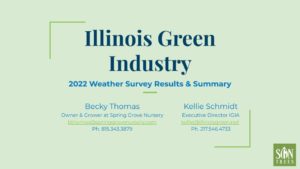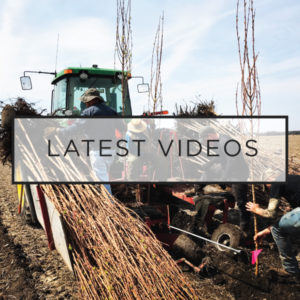Becky Thomas, Spring Grove Nursery, and Kellie Schmidt, Illinois Green Industry Association, presented at the Illinois Climate Services Summit in Champaign on Sept 7, 2022. After surveying growers from across the state regarding their weather and climate data usage and needs, they shared the results and feedback with a group of state & federal climatologists. We will share here a copy of the presentation and the results, along with a report from what we learned at the summit. Thanks to Illinois State Climatologist, Trent Ford, for inviting us to share how weather affects Green Industry growers & businesses!
Here is a link to a previous blog post referencing the Illinois Climate Summit and our survey to growers: Illinois Climate Services Summit Sept 7 & 8
Illinois Green Industry – 2022 Weather Survey Results & Summary
* Becky Thomas, Spring Grove Nursery
* Kellie Schmidt, Illinois Green Industry Association
Thank you for the opportunity to share with you how weather & climate affect our Green Industry businesses. My nursery, Spring Grove Nursery, is located in north central Illinois, right in the center of Grundy County. We are wholesale growers of field-grown trees on 100 acres. I am presenting today with my colleague, Kellie Schmidt, from the Illinois Green Industry Association. The IGIA represents growers, greenhouses, garden centers, and landscape contractors from across the state.
Like most ag businesses, our nursery is part of a family farm. I grew up on a corn & soybean farm, and weather has always played a central role in my life. As a kid, the rain gauge & the front porch were key tools in how weather affected our farm. We spent many hours on our east facing front porch watching storms roll in and the rain pour down. After a storm, my dad would immediately check the rain gauge – compare with all of the neighbor’s rain gauges – and know exactly what that would mean for the crop and the field work to be done for the rest of the week. I can count on my hand the number of “significant” weather events that left us scrambling. Once there was a Mother’s Day wind storm that stripped the soybeans right out of the field and a few times I remember flooding that required replanting. But, for the most part, the weather & climate were relatively predictable from season to season. My dad was an innovator and we were one of the first farms to have that old DTN screen with weather & markets, and then eventually our own Davis weather station where we could check wind speeds for spraying and record our historic weather data on the farm.
Fast forward to today, my husband and I operate a tree nursery on our family farm. We have been growing trees on our farm since 1999, and we have experienced lots of weather in our 23 years as growers. We have a Davis Vantage Pro 2 weather station up at the nursery that we can monitor on our phone app. We can also log in and check all of our neighbor’s weather station data. The Weather Underground app on our iPhone is our go-to for current radar and the short-term & long-term forecasts. And for those of you in the WGN territory, of course meteorologist Tom Skilling at lunch and 9pm. We now live in that same farmhouse with the east facing porch, and we still watch the storms roll in and wonder how it will affect our crop. Some things never change!
To prepare for this summit, Kellie & I polled the IGIA membership to see how weather & climate affected member’s operations. As you can see, the IGIA is made up of a mix of growers from across the state producing plants in a variety of methods. Some businesses are more retail-focused, while others like mine are more wholesale-based; at the end of the day, we all grow for the consumer. The Green Industry in Illinois is very diverse, but a common thread that binds us all together is weather.
In recent years, some trends seem to be emerging in our market. Since the pandemic, we have seen a sharp increase in new gardeners engaging with plants. People are planting more for climate change and are interested in impacting their local environment with things like pollinator gardens. On the business side, we are faced with challenges such as supply chain issues, labor shortages, and rising input costs. Some of that is still residual from the pandemic, but there has also been a shift in demographics of our labor pool and reduction in nursery acreage across the country. What also seems to be emerging as a “trend” is more frequent major weather events and a changing climate that is hard to predict or anticipate.
Before I share the results of our weather survey, I want to explain a few ways weather & climate affect Green Industry operations. Looking at this from the big picture, it can be broken down into the areas of Production, Sales, and Forecasting.
Every aspect of production is affected by weather & climate. In field growing operations like mine, our planting and harvesting occurs during a very specific seasonal window dictated by temperature. In the spring, we have a short period of time to harvest our crop – between when the ground thaws and when the trees leaf out. We also plant our new crop during this same window. Dormant planting & harvesting allow us to safely produce our plants for market. In “normal” seasons, we usually have from around mid-March to mid-May and then mid-October to late-November. There is a short window of time to get our work done, which then generates our sales for the rest of the year; every minute counts.
During the growing season, many growers use timing models to know when to apply pesticides. Grower Degree Days are commonly used to match when pests are emerging or when the appropriate applications will work the best. A fellow grower, John Terhesh at Goodmark Nurseries, put a GDD resource right on their website so you can look up what pest to be watching for. (I put a link to that at the end of this presentation.)
Growers that produce containers in hoop houses or greenhouses, use historic and current weather data along with forecasting models to decide when to cover or uncover crops for frost or freeze protection during growing seasons. And the day to day operations are always dictated, first and foremost, by the weather.
Weather & climate can also affect production on a longer term. My crop of trees will grow in my field for 3-8 years. That time span depends a lot on the growing seasons. The speed in which a tree will come to market in my field has many variables that affect it along the way – mostly moisture & temperature. A “good growing season” can sometimes shave a whole year of production time off of a tree crop. A “bad weather event” can entirely eliminate a species from my field. We have seen both of these things happen at our nursery many times. The polar vortex a few years back killed 3 different genus of trees across multiple crops in our field. We get our tree liner crops from Oregon, so when they experienced record high temps of 118 degrees last summer it affected our liner supply this spring.
In the area of Sales, weather & climate also have a huge impact on our industry. The spring season brings in the majority of sales for the Green Industry. If it is a cold, wet spring – especially on the weekends – sales are lost in garden centers. Conversely, an early spring warm up might cause a shortage of plants later that production cannot re-supply fast enough. The end consumer also drives the demand for what growers produce. For example, our typical plant hardiness zones are being put to the test lately with consumer demand wanting “warmer zone” plants that some growers might be cautious to produce.
Large scale planting programs like the Chicago Region Trees Initiative have brought attention to the declining urban tree canopy. The program has been marketing to the public about the importance of planting trees and in turn creating awareness about plants & climate to the general public. A more “climate conscious” consumer is starting to emerge as younger buyers enter our marketplace and begin to drive demand.
As growers, we are always planning ahead – often up to 5 years of production & sales planning at a time. Weather & climate have greatly impacted the area of forecasting in our operations. We are constantly using production & sales data together to project what to grow and how much of it to produce. With slim margins and a tight labor force, we don’t have much wiggle room for adjustment. Because our crop is long-term, we experience countless variables along the way that can affect our end result. So besides just growing plants, growers are also constantly trying to mitigate risks.
In the last 5-10 years, unexpected or unpredictable weather seems to be making this part of our job much harder. As I mentioned earlier, I can remember every major “weather event” that happened when I was a kid. Now it seems like we have multiple life-changing weather events each season. From polar vortex temps and excessive heat indexes to severe spring drought and 100 year floods – all of these within 1 crop rotation of trees – it’s a wonder we can forecast anything!
But that’s what you folks are for, right? Can we just order up the predictable weather we want from you? That’s the app I would like!
Kellie & I polled nurseries, greenhouses, landscape contractors, & garden centers across the state. We asked 9 questions related to weather & climate, and we received back 21 responses. We compiled the data and included Growers’ comments so that everyone could have a voice in sharing their experience with weather & climate in regards to their operations. I will have a link to these results on my website so you can read them in more detail later.
What sources do you use to get your daily weather data?
- Majority said Phone Apps (75%)
- Accuweather, 1Weather, WeatherBug, Weather Underground, Dark Sky
- Around half use a combination of TV, Internet and Radio
- The Weather Channel, Local News, and the National Oceanic and Atmospheric Administration (NOAA ), Weather.gov
- No one used Meteorological Assimilation Data Ingest System (MADIS)
- Additional sources mentioned were:
- Grower Degree Days
- Look outside
- Rain gauge
- Siri/Google Home
Do you use climate outlooks?
- YES – 53%
- Someone noted www.cpc.ncep.noaa.gov
- NO – 47%
- Comments were that they are inconsistent & unreliable
What timeframe of weather/ climate data is most useful to your operation?
- Almost everyone said they use 5-7 day forecasting models
- Other respondents use 2-week, 1 month, and 3 month outlooks in addition to the 5-7 day
Is there weather data or climate change info that would be useful to your growing operation but isn’t currently available in our industry? If so, what?
- 50% said YES
- “Actual precipitation expectations with breakdown by the hour”
- “Finding the local Dew Points can be difficult based on apps. We use this in Spring and Fall to tell us what the chances of a frost are.”
- “GGDs as pertains to ornamental pests, i.e. Pine Sawfly is coming soon because Spirea vanhouttei is blooming”
- “All of our weather forecasts are generated from urban areas, which do not always align with rural areas. This is especially tricky with the first frost/freeze of fall and last frost/freeze of spring.”
- “Seasonal rains and temperatures, generally anything out of normal ranges. Rain and heat for spring is the biggest concern.”
- “Accurate long range forecast”
- “Anything related to changing patterns in terms of warming up in spring and cooling down in fall. It seems like spring is cold and wet later into May which messes with our production timelines and plant ready dates. Fall seems to be more mild later into Nov/December, so does this change our outlook on safe planting times and how late we can install material? Or, are these last few seasons outliers?”
What aspects of climate change are most concerning to you related to your growing operation?
- Top concerns?
- Extreme temperature changes
- Changes in rainfall patterns, drought/wet seasons
- Other Concerns:
- Unpredictability of the weather patterns
- Increased severity of storms
- Changing wind patterns
- Changes to air/water quality
- Additional climate change comments:
- “‘False’ springs and early wake up of crops followed by hard freezes.”
- “Rainfall in patterns – we’ll need to switch from our retention pond water to our well water. Intense storms don’t allow us to capture as much water as lighter storms that occur in more frequent intervals. Not sure there’s anything we can do to change this without significant capital expense, so should we plan on less frequent rainfall and more downpours/ intense/ intermittent storms instead?”
- “Extreme heat seems to be an interesting factor in our day-to-day operation. This is a concern for our employees working in the heat as well as moving trees in the extreme heat. It seems to have a great impact on trees after they are planted as well. I am very interested in keeping data on weather temperatures when we see loss after transplant.”
Do you use weather data in your operation on a daily/weekly basis? If so, how?
-
- Planning irrigation and labor during heat/drought times
- To plan when to do certain things when the weather is more favorable, i.e. pruning evergreen trees when it is not too hot and humid
- Keep track of rainfall and soil conditions to work the fields and water our plants
- Pesticide/Herbicide application
- Digging/planting starts and ends
Do you use weather data in your operation on a long-term planning basis?
- Pesticide/Herbicide application
- Digging/planting starts and ends
- Sales forecasts
- When we need to start transitioning our production crews to water & maintenance work
- Safe planting times for late season installs & start times for spring installs, H2A/H2B workers and when to get them here, covering and uncovering of production huts
What devices do you use to access weather info?
- Everyone said their SMARTPHONE
- Majority said Computer, Rain Gauge, and Personal Weather Station
- Around 25% of respondents said Television and Radio
- Others Responses
- Standalone Weather Radio
- Google Home
- Alexa
What elements of weather data are the most pertinent to your growing operation?
- Everyone said: RAIN!
- Majority also said:
- Temperature
- Wind
- Weather Forecast
- Growing Degree Days
- Humidity
- A few responded:
- Historical Data
- Other Comments:
- “I wish there was more information on how to use Growing Degree Days”
- “Sunlight/cloud cover totals/location”
- “Rising temperatures, severe storms, wind, drought”
- “We need apps with more accurate rainfall totals compared to previous seasons, apps which tell you what actually happened over the last 2-3 days, so we can compare and adjust accordingly”
So where do we go from here? This summit is a great start! Not only did it bring all of us here today, but it has facilitated lots of side discussions within all of our various organizations & businesses in preparation for it. Sharing data and ideas across industries is necessary for healthy and sustainable growth for everyone.
Education is key. In conversations with other growers to prepare for this presentation, I was surprised at how little we all actually know about weather & climate data. Where to get it, what it means, how to use it… Hopefully my presentation today will spark additional conversations between our industry and the providers of data so we can get the info we need in a timely manner. Maybe it’s already out there and we just don’t know about it?
In reading through most of the comments from other growers, it is obvious to me that the forecasting piece of this puzzle is what weighs the most on all of us. How can we better incorporate climate data into our business practices so that we can mitigate our risks and make better decisions for the future. Still looking for that “Magic 8 Ball” weather app!
As a greater community, we can all work together to support climate change mitigation efforts. Partnering together in research efforts might be helpful in providing the data needed to develop products or policies that benefit our communities and businesses.
Collaboration is important, and I look forward to learning more from all of you these next few days. I hope this presentation has given you an inside look into our Green Industry and how weather & climate affect our operations.
I will post this presentation on my website where you can access these individual survey responses and data. Please feel free to reach out to me or Kellie with any questions or follow up collaboration. Thanks for your time!





Leave a Reply